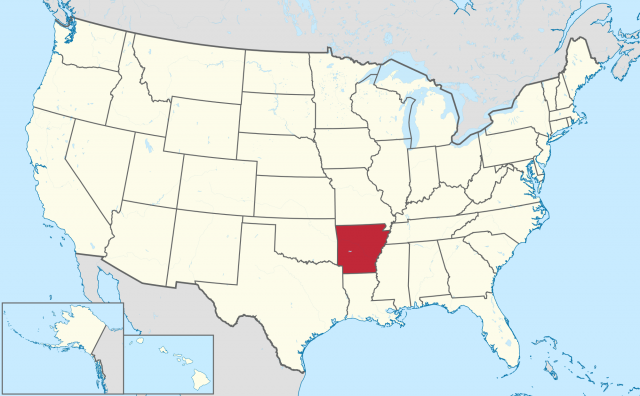Arkansas
ITS NAME DERIVED from a French-adapted Native American term meaning “downstream people,” Arkansas is the 27th largest state at 53,104 square mi (137,539 square km). The state's shape is almost like a box, as its north-south extent is 240 mi (386 km) and the east-west extent is 275 mi (443 km).
Located in the mid-Southwest UNITED STATES, landlocked Arkansas is bordered by six other states: MISSOURI, TENNESSEE, MISSISSIPPI, LOUISIANA, TEXAS, and OKLAHOMA.
The longest river in Arkansas is the White River, a tributary of the MISSISSIPPI, running 1,485 mi (2,388 km) to the southeast. The largest lake in the state is an artificial one, Lake Ouachita (60 square mi or 155 square km), located in the middle west of the state. The largest natural lake in the state is Lake Chicot, which is an oxbow of the Mississippi in southeast Arkansas.

There are several distinct physical regions of Arkansas. In the northwest are the highlands of the heavily forested Ozark Plateau and Boston Mountains. South of this area is the Ouachita Mountain range, which includes the highest peak in Arkansas, Magazine Mountain, at 2,753 ft (839 m). The rest of the land in Arkansas is mainly lowlands of the Mississippi valley. This is where the most fertile soil of Arkansas is located. Nearly half of Arkansas is covered with forests. In the Mississippi plains, there are the hardwood forests, consisting of such trees as elm, oak, and ash, and the softwood forests are in the western area, consisting mainly of simply pine trees. Arkansas is also host to many flowering trees, such as the dogwood and the red haw. The state has a wide range of animal life, with fish such as perch and drum, birds such as geese, ducks, and turkey, reptiles like snakes, lizards, and turtles, and mammals such as deer, bobcats, and minks, all call Arkansas home.
The CLIMATE of Arkansas is moist and mild. There are warm/hot summers and winters are cool. The highland region is slightly cooler. Littler Rock, the capital, has average temperatures of 40 degrees F (4.4 degrees C) and 82 degrees F (27.7 degrees C) in January and July, respectively. The 49 in (124 cm) of annual precipitation comes mostly in the winter and spring. There is a slight difference between the north and the south of the state, where in the north, more specifically the Ouachita Mountains, rainfall averages 54 in (137 cm) a year. In Little Rock the average is 42 in (107 cm) a year. One of the great dangers in Arkansas is TORNADOES; the far north and southwest parts of the state are the most prone to them.
Arkansas was first explored in 1541 by Hernando de Soto for the Spanish, but it wasn't until 1673 that Jacques Marquette traveled the Mississippi to Arkansas and declared it to be French land. John Law, in 1717, attempted to set up the first settlement in the Mississippi valley, but it failed. In 1762, the French ceded the territory over to the Spanish, but then in 1800 reclaimed it, only to sell it three years later to the United States, in the famous LOUISIANA PURCHASE. Three years after, that the District of Arkansas was created, and after a slow development, more than 30 years later Arkansas was admitted as the 25th state of the Union.
Arkansas is a landmark for civil rights history, as in 1957 and 1958, when the Supreme Court case of Brown v. Board of Education was challenged by the governor of Arkansas at the time, Orval Faubus. President Dwight Eisenhower called in troops to ensure that African Americans were integrated into Arkansas public schools.